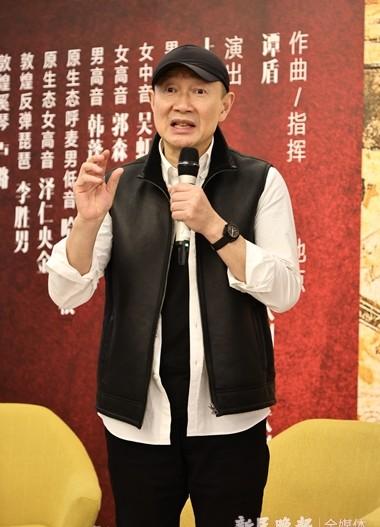
Tan Dun Xinmin Evening News reporter Wang Kai photographed the same
Tonight, the Chinese music "Ode to Dunhuang Mercy", co-hosted by the Shanghai Chinese Orchestra and the Shanghai Grand Theatre, and created by Tan Dun, will premiere as the 2022 New Year Concert of the Buick Masters Series at the Shanghai Grand Theatre. At the performance site, Dunhuang rebound pipa, fengshou basket and Dunhuang Xiqin, three instruments "walked" out of the mural, will use musical notes to pave a Silk Road that can be listened to. When the traditional Chinese national instruments are played together, the ancient music of Dunhuang a thousand years ago seems to truly "come alive", revealing the prosperity and beauty of the dust for a thousand years, and reproducing the glory and splendor of the Silk Road.
Dunhuang Relics shows cultural self-confidence
Different from the original symphonic version, the Chinese music "Dunhuang Ode to Mercy" was commissioned by the Shanghai Chinese Orchestra to create an international music master Tan Dun, which took two years to "recreate", on the basis of dozens of trips to Dunhuang to learn from the style, drawing on the integration of Dunhuang music and dance ancient music and Tang Dynasty court music, highlighting the timbre charm and rhythm characteristics of ancient Chinese music.
Liu Xuanyi played the basket
"Dunhuang Ode to Mercy" is based on Dunhuang murals and folklore, and the Chinese music version is divided into six acts: "Bodhi Tree", "Nine Colored Deer", "Thousand Hands and Thousand Eyes", "Zen Garden", "Xuanzang Donggui", "The Other Shore", in the form of epic poems, the dramatic plot of the murals is told, through the wonderful resonance of national music and millennium murals, showing the philosophical ideas, humanistic values and moral norms of Dunhuang culture on the ancient Silk Road, revealing the cultural spirit and cultural mind of the Chinese nation, and activating the vitality of Dunhuang culture.
Luo Xiaoci, director of the Shanghai Chinese Orchestra, said: "The development of Chinese art to this day is closely related to the times. The strength of the country is reflected in the confidence in its own culture and music, which requires high-quality creation and performance. The subject matter and content of folk music may be traditional, but the way of expression must be contemporary. We should create more excellent musical works and make it a window to show Chinese culture. ”
Ancient musical instruments in the murals are revitalized
For the performers of the Shanghai Chinese Orchestra, playing Dunhuang ancient instruments is also a new challenge and breakthrough. The Dunhuang Xiqin played by lu Lu, an erhu player in the orchestra, can be seen as the ancestor of the erhu, but there is a big difference between the two in terms of the feel and appearance of the instrument.
"The erhu is a single musical instrument with only two strings, while the Dunhuang Xiqin has three strings, and it can use the two strings of the bass at the same time to cleverly play the effect of four degrees of two tones, which is very interesting." Lu Lu said: "This time we chose the first generation of Dunhuang Xiqin, in terms of rhythm and pitch it is not stable enough, it is a test of control and stability, but whenever I hear the sound that contains thousands of years of culture, it gives me a strong sense of substitution, hoping to show the Dunhuang music to the audience in its original flavor." ”
Lee Seung-nam performs a rebound pipa
Orchestra pipa player Li Shengnan will present the well-known rebound pipa in the Dunhuang murals in tonight's performance: "The Dunhuang rebound pipa is very different from the pipa we usually play. Because of the difference in the fixed string, the position of the left hand takes a long time to adapt. In addition, in the practice, I also tried to get used to different playing postures, the lute was originally played vertically, and during the rebound process, I could not see the 'product' part of the left hand of the pipa, and through continuous practice, I achieved the effect of 'blind playing' today. At the same time, in this concert, I also performed music and dance on stage for the first time, recreating the dance posture in the Dunhuang murals, which was a bold attempt and breakthrough for me. ”
"On the basis of the one-to-one restoration of the Dunhuang mural phoenix head basket, the phoenix head basket in the concert added a row of strings, which is more in line with and convenient for modern performance." Liu Xuanyi, a performer at the Shanghai Chinese Orchestra, said: "After the restoration of the Phoenix Head Basket with the Flying Dance, when you pluck the strings, you feel that you are the flying goddess who plays the Basket." In addition, baritone singer Shen Yang, mezzo-soprano singer Wu Hongni, tenor singer Han Peng, soprano singer Guo Sen, Tibetan primitive soprano singer ZeRenyangjin, Mongolian original Humai bass hasbagan will also bring that "distant call" to the audience. (Xinmin Evening News reporter Zhu Yuan)